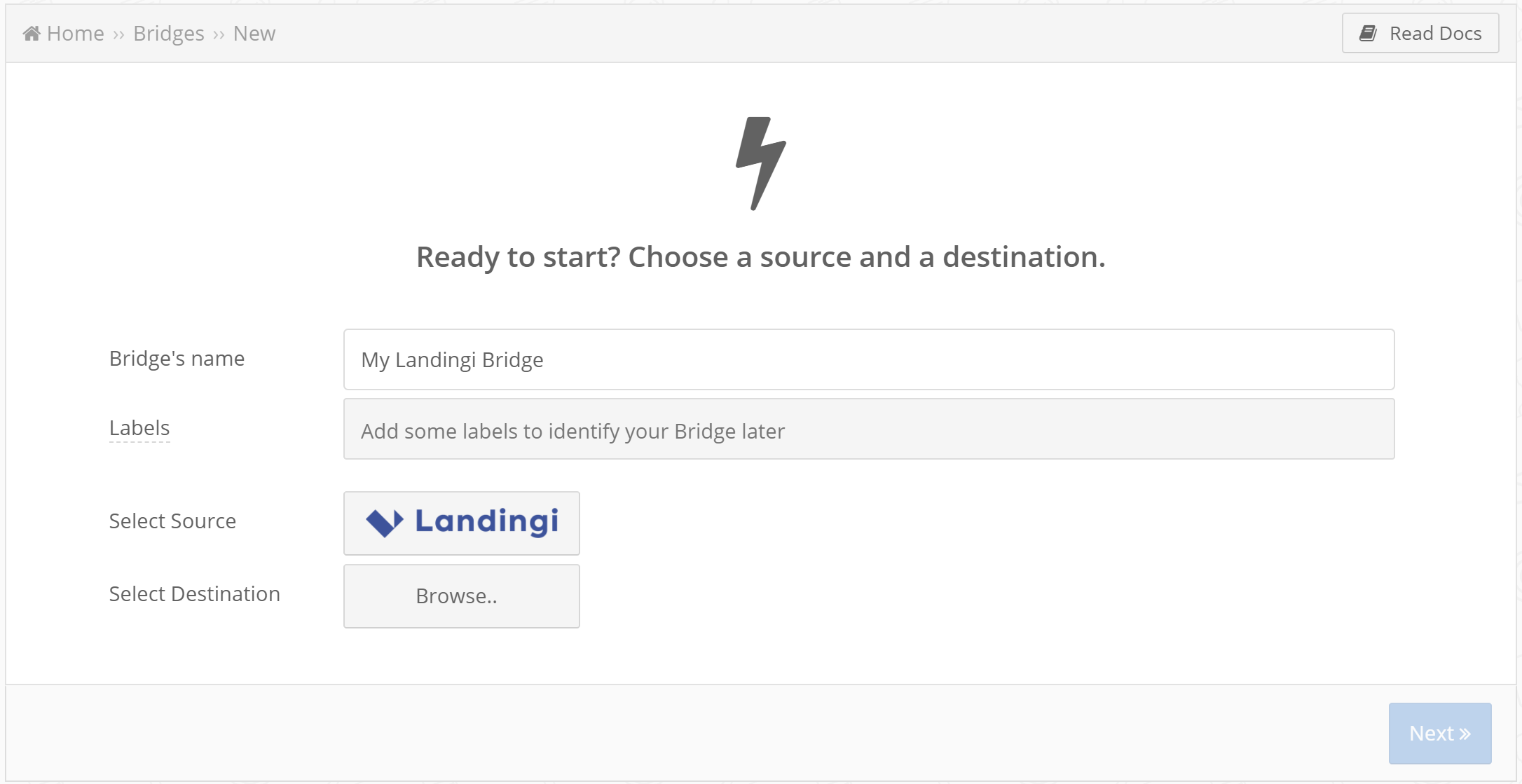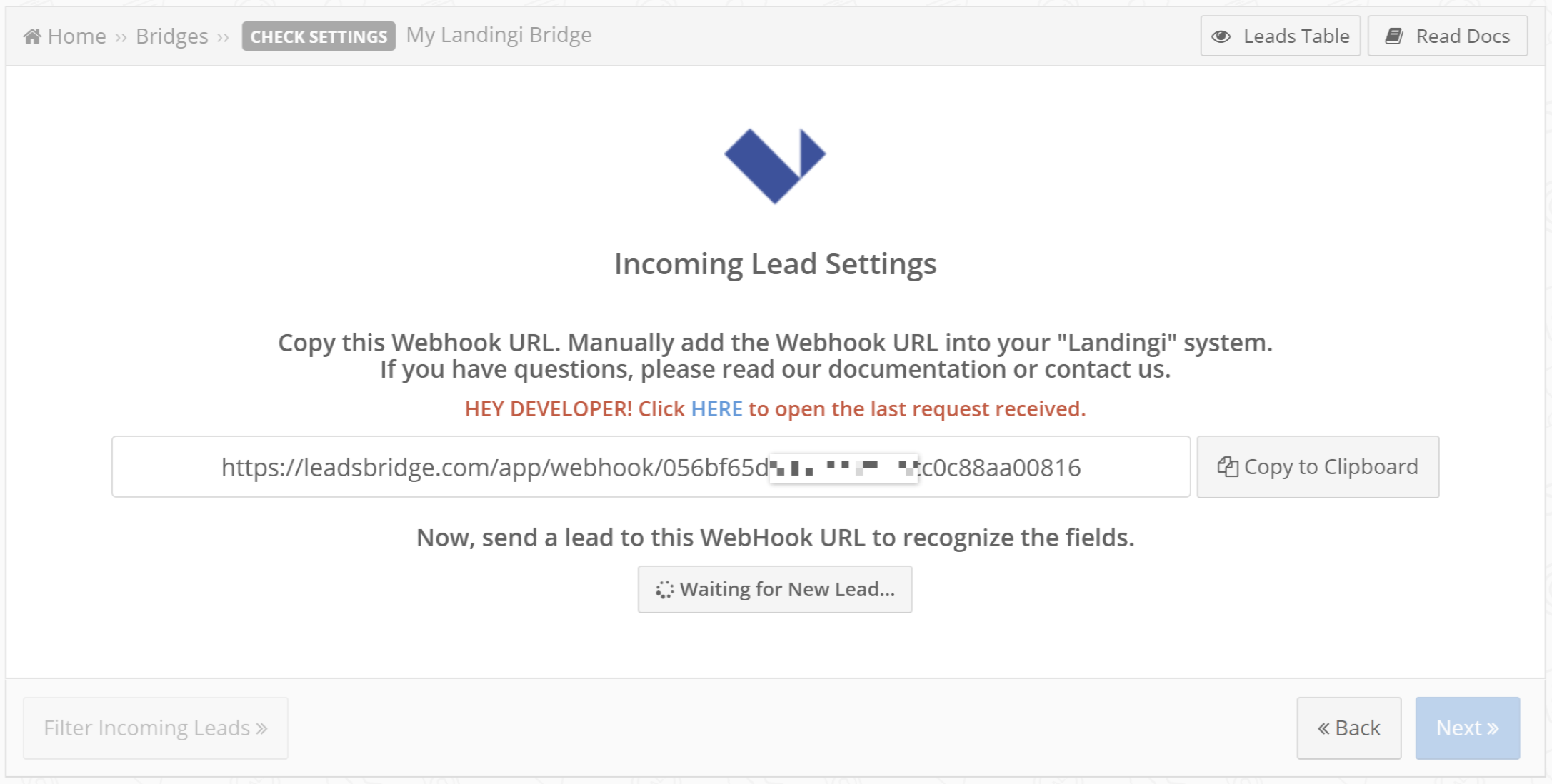Connect Landingi to PandaTS (RB) with LeadsBridge
 »
» 
In this article, you'll learn how to set up the bridge and connect Landingi to PandaTS (RB) using LeadsBridge.
How to set up your bridge step-by-step tutorial
Before you start
Step 1: Bridge's Main information
- Choose a name for your bridge (this will only be visible inside LeadsBridge)
- You may add labels to help you identify your bridge later
- Choose Landingi as the source for your bridge
- Choose PandaTS (RB) as the destination
- Click on the Next button
Step 2: Setup your Landingi source
You may send lead's information from Landingi to LeadsBridge through the Webhook feature.
Copy the Webhook address that you see in this step and set this endpoint as the data receiver inside your Landingi settings.

How to setup the webhook on Landingi
Landingi gives the possibility to send lead’s information to a Webhook URL, this is set up in the form settings. Create the bridge and select Landingi as Source. In the source step, you’ll see a URL address, set that endpoint as the data receiver inside your Landingi form settings.

Set the Webhook with lead information in a form by following the steps below:
- Log in to your account in the Landingi platform. Then go to editing the selected landing page.
- In the editor, go to form settings. On the left, enter the Integrations and choose integration with Webhook.
- In the Request URL field, paste the URL provided by LeadsBrdige during the Bridge creation.
- In the Request method field, select POST.
- Map the Landingi form fields with the fields that you would like to receive in LeadsBridge.
- In the Request Headers fields, set the request headers that will be sent each time the form is sent. Remember that each heading consists of two parts: key and value, e.g. API_KEY: 1234-abcd-5678, where the first field concerns key and the second - value.
- In the Request parameters fields you can set additional parameters that will be sent together with the form. Similarly to headers, it consists of two parts: key and value, which should be completed. For example, if we have a form with an email field and we set one parameter source:landingi, then each time someone sends this form, the query will send data to the API: email: marta@test.com (or what the user enters in the form) and source: Landingi. The request parameters perform almost the same function as the hidden fields in the form, but their advantage is that they are invisible from the page code.
Before proceeding
One last thing before proceeding to the next step is to send a test lead from Landingi. This will allow us to recognize the attributes you'd like to pass along and offer them as presets in the next steps of the setup.
- Please make sure the LeadsBridge screen is saying "Waiting for New Lead...", it means that we're ready to receive your test data
- Go to Landingi
- Submit a test lead
- Once done go back to LeadsBridge and verify that your test was sent successfully
- You should see the information processed correctly by the app
- Click on the Next button
Step 3: Setup your PandaTS (RB) destination
- Type in the integration's name in the dedicated field
- Enter Partner ID and Partner Secret Key to connect PandaTS (RB) with LeadsBridge
![]()
- In order to retrieve the Partner ID and the Partner Secret Key, we suggest you to ask to your Panda TS (RB) support.
- Click on the Next button
- You'll now be able to select the destination segment to send your leads to
- You may choose to receive an email receipt for each incoming lead.
![]()
- Type the address(es) where you'd like to receive the receipt
- You may also modify the Subject line of the email
- Click on the Next button
Step 4: Fields Mapping
Here you'll be able to map your source information with your destination fields.
You'll see a field name with the destination integration's logo at the top, this indicates the name of the field on PandaTS (RB).
Underneath there's a box where you may add the information you'd like to send.
- Check each of the PandaTS (RB) fields available
- Match the information you wish to pass along from Landingi
- You may type the information manually and pass them as a static value
- Use the functions to customize information like reformatting dates and times or modifying text, phone numbers and so on
- You may also leave blank the box of a field's information you don't want to send through
Custom Fields
- If you'd like to add more fields, just look at the bottom of the page
- Head over the "Don't find a CRM custom field?" box
- Select the field you'd like to add from the dropdown list
- Click the Add Custom Field button
![]()
- The field will appear above
- Add the desired information, as you did with the other ones
Once accomplished your desired outcome, just click Next and head to the last step.
Step 5: Test
In this final step, you'll be able to send a lead from LeadsBridge to test if the configuration works properly.
- To create a new test lead, fill in the required information when prompted
- Click Test Now
- To test with a real lead, switch the toogle to "Test with existing lead".
- Click Sync Now along the lead you'd like to send
- If you did everything right the button will turn green, meaning your lead was synced successfully and the integration is ready
- Click Finish to save your settings and turn active your bridge
That's all! Congratulations.
You'll be redirected to the bridges section of your account with a green success message at the top right of the page and your bridge will now be active.
Have you got some questions?
You may want to take a look at the common questions on the respective integration's documentation.
- Source: Landingi
- Destination: PandaTS (RB)
If you have any other questions, or need help to configure your bridge from Landingi to PandaTS (RB) with LeadsBridge, do not hesitate to contact our Support!





